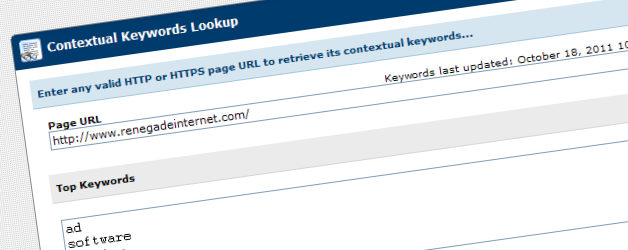Greater Relevancy = Increased Profits
Contextual targeting enables you to more effectively target campaigns to relevant pages by matching keywords and phrases within the full text content of those pages. Advertisers are willing to spend more money for their ads to be placed on pages that contain relevant keywords or phrases. Why allow content advertising networks to collect the lions share of that money? With contextual targeting, you will be able to sell those advertisers directly and increase profits by completely cutting out the middle man.
You can also stretch your inventory to increase profits even further with contextual targeting. Say that you have an advertiser who buys 250,000 impressions every month at $10.00 CPM and you deliver those impressions run of site. Maybe their ads aren't quite relevant to every page on your site though? Why not sell them 100,000 impressions only on relevant pages at $25.00 CPM instead? You still make the same amount of money ($2,500/month), your advertiser will be happier because their CTR will appear higher from having fewer impressions and you have 150,000 extra impressions that can be sold to another advertiser for an increased profit of $1,500/month.
How Contextual Targeting Works
- Generate a zone code with the Code Wizard and check the Contextual option to enable indexing of pages where you will place the zone.
- Place the generated zone code in your page(s). Secure pages are supported too!
- The zone code triggers the web crawler component of the contextual targeting module to create a full text index of those pages as they are visited. This on-demand process happens in less than half a second the first time a new page is discovered. The ad server will then cache the page index for 1-24 hours (configurable) so there is very little impact on the performance of your site and the loading speed of your ads.
- Campaigns can then be targeted to keywords and phrases in your pages. Exact and fuzzy matches of keywords are supported. Boolean operators (+/-) are also supported to require combinations of words, so you can actually require multiple keywords or phrases to be present in a page together. You can even require certain keywords or phrases to occur a minimum number of times to guarantee greater contextual relevancy.
- The most relevant keywords from your pages can later be reviewed by generating a keyword report, which is a great sales tool that helps you estimate how many impressions certain keywords generate on average.
Where Contextual Targeting Excels
Lets say that you operate a web site that covers home theater equipment. The big attraction to your web site is a forum where enthusiasts can discuss all of the latest home theater audio and video gear. Over the years the forum grows to be home to several hundred thousands posts. How could you possibly target ads to all of those post pages? You use keyword targeting! The contextual targeting module uses a web crawler to full text index your forum post pages on-demand and it caches pages for a short time (4 hours by default) so it won't overload your server.
Another great example would be a blog. Maybe you have popular blog about food and you like to post your favorite recipes regularly, but your tastes are all over the map. Even so, you have advertisers interested in advertising on posts featuring recipes that include ingredients they sell. Here's where your problem comes in: all of your blog posts share the same page template so you are stuck with using the same zones for all of your posts. To pull this off you absolutely need contextual targeting so that you can target campaigns only to posts that mention key ingredients.
How about advertising networks? Even if you run a niche network there can still be a lot of potential for increasing relevancy and optimizing inventory usage with contextual targeting.

 Mike Cherichetti
Mike Cherichetti
